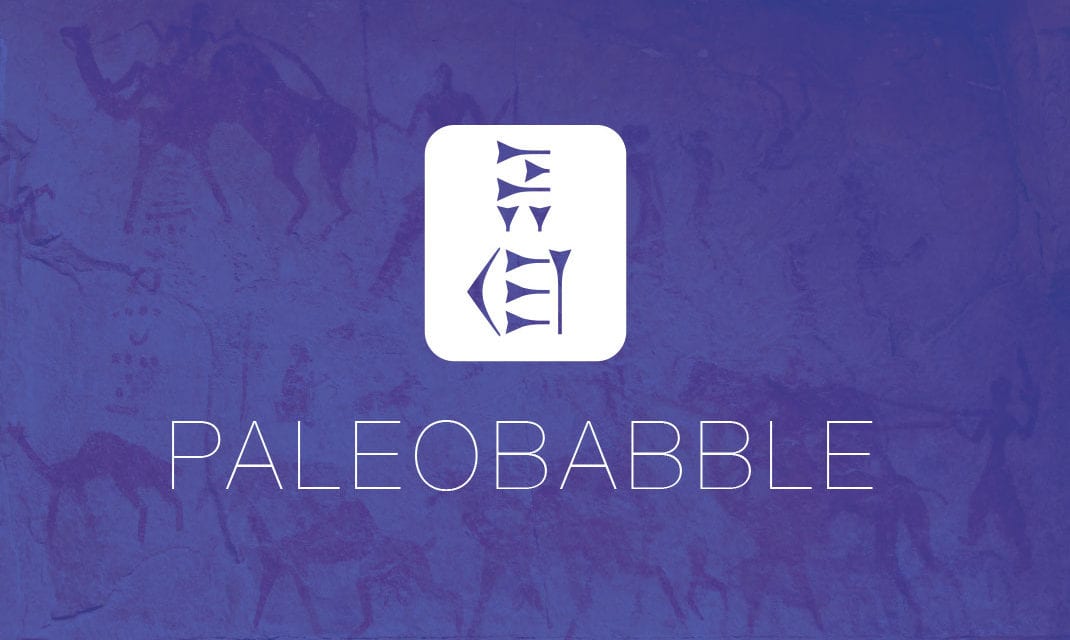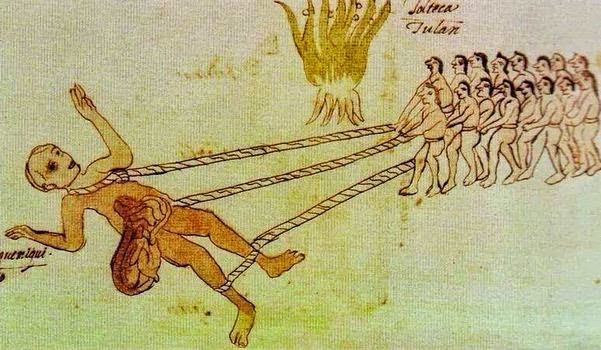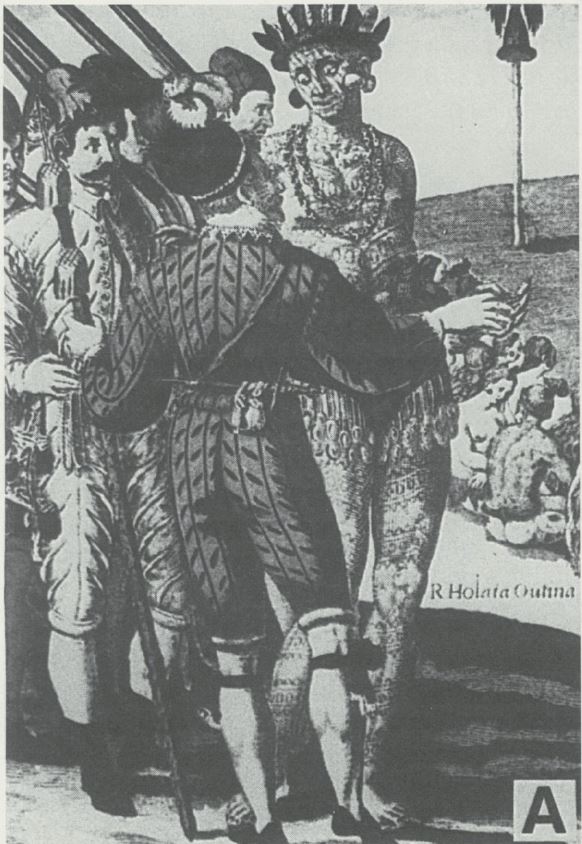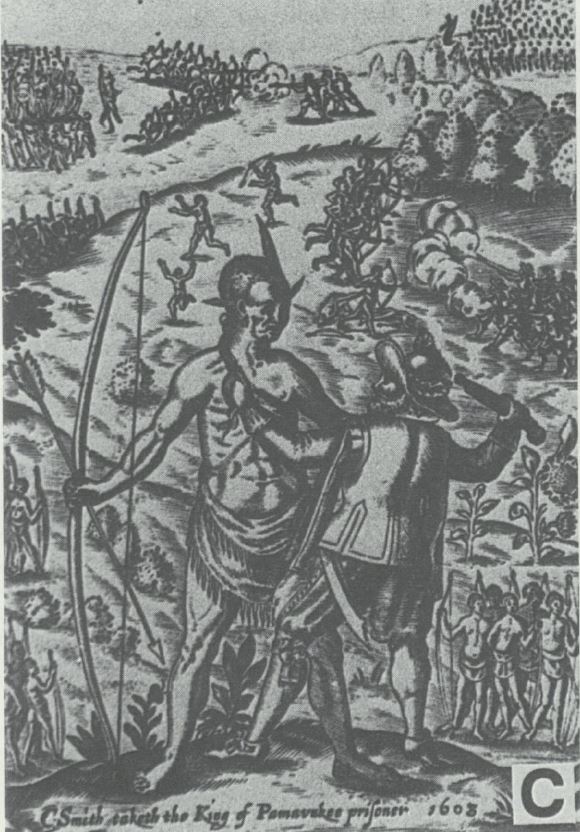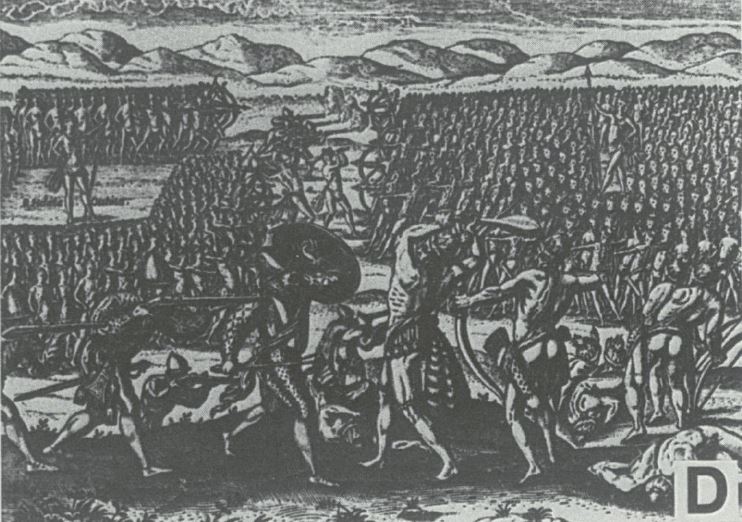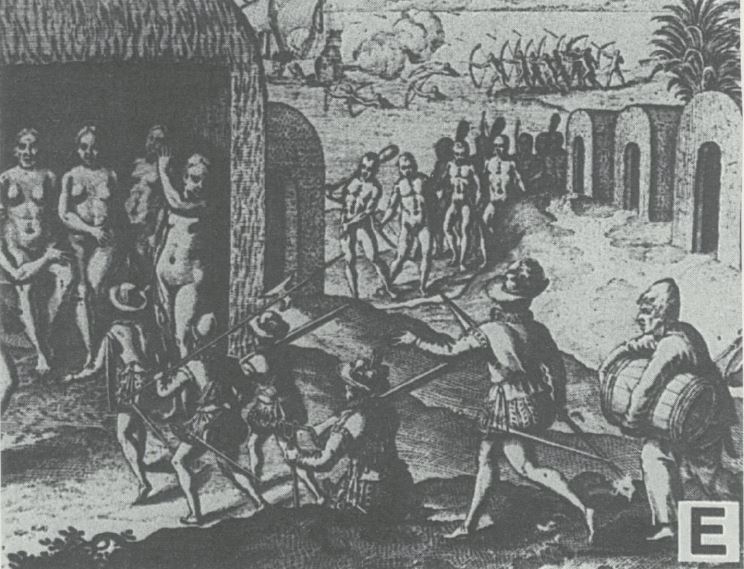Please be patient with the images loading.
Several weeks ago I received an email with a YouTube URL about “legitimate” giants in ancient Mexico. I watched it and learned about Mexican “giants” called Quinametzin. The evidence offered in the video was the picture below:
The source from which this image comes is a (time for the spooky music) manuscript housed in the Vatican.
Sigh.
So what do we have here? First the simple observations:
1. Presuming the picture portrays someone unusually tall (close to or exceeding 7 feet is typically how I define “unusually tall” for these discussions), so what? A single giant doesn’t mean proof a race of giants any more than NBA players provide proof of such a race. It also doesn’t lend any credence to what the video poster wants people to come away with — something monstrously tall, ca. ten feet or more.
2. Where is the evidence of ancestry in this picture (or its source) to the nephilim? To any Semitic context?
3. On what basis would we not expect an occasional unusually tall person in any cultural context?
But setting aside simple, logical questions such as these, let’s get into the data at hand. First the manuscript.
Codex Rios
The manuscript source for this image (purportedly – I don’t have access to images of it to verify this image even appears) is known as Codex Rios. Information isn’t widely available in English on this codex, but I did find this article,1 which reads (p. 19) as follows.
… [There is a] Mexican codex, the 101-folio Codex Vaticanus 3738, also known as Codex Vaticanus A or Codex Rios, which is regarded as a copy of the Codex Tellertano-Remensis, including the comments of Fray Pedro de los Rios, made by an indigenous painter in Mexico in the year 1562. It is the only colonial Mexican manuscript to feature a lengthy, systematically composed Italian text to explicate its images. From the fact that the commentary in the codex was written in Italian it is clear that the intention was to send it to Italy. It certainly entered the Vatican Library before 1600; and the reference to Amulio, who died in 1570, would seem to indicate that it entered the library very soon after it had been completed, i.e. during 1565-66.
Both the Telleriano-Remensts and the Vaticanus A contain mythological material,105 but the latter contains additional ethnographic and mythological sections which are not found in other ancient Mexican manuscripts, such as the depiction of the Aztec cosmos with its thirteen celestial layers and nine levels of the underworld on the first two facing folios of the codex (fols. iv-2r).
Note the last line. This manuscript, which we presume contains this image of a “giant” called Quinametzin, also informs us that the Aztecs believed in a cosmos with 13 layers and various levels in the Underworld. Sorry, but that isn’t exactly accurate information. We know the cosmos isn’t layered thirteen times over. This, along with the Underworld language, is the language of “spiritual geography,” the kind of geography that doesn’t actually have latitude and longitude, but serves to talk about the realm of the gods and the afterlife. In other words, it isn’t scientific — something that can be measured and observed in the human, terrestrial world. Consequently, the manuscript can’t be relied on for scientific information. I’m already wondering about the “giant” — in terms of really having a giant (as opposed to someone taller than pretty short people — see below).
Note as well that this “Vatican manuscript” isn’t a secret manuscript. It’s been known for over 450 years. Whatever secret conclave or guild in the Vatican charged with hiding “dangerous manuscripts” in the Vatican of the sort that conspiracists love to talk about looks pretty inept right about now.
But wait, there’s more . . . specifically: (1) what about these Quinametzin in other sources, and (2) Are our eyes deceiving us about the height in this image?
Actual Skeletal Remains
As luck (er … research) would have it, I came across an article that sheds light on the matter:
Mehmet Yasar Iscan and Morton H. Kessel, “Giant Amerindians: Fact or Fantasy?” Southeastern Archaeology vol. 16, No. 1 (Summer 1997), pp. 73-78
I can’t post this one, but a few excerpts and images will make the point.
The article focuses on images that have come down to us from the same era as that (presumably) in Codex Rios, the 16th century. On the first page (73) we read:
Artists like Jacques le Moyne de Morgues (French engraver /painter, sixteenth century), John White (En- glish artist, sixteenth century) and Theodore de Bry (Flemish engraver, late sixteenth century) have also depicted Indians as tall (Lorant 1965; Milbrath 1989). These renderings, done in the sixteenth century shortly after Spanish contact, include many interesting historic details. As can be seen in Figure 1A, de Bry drew the Timucuas as giants dwarfing the French explorers (Lorant 1965; Lyon 1989). Bennett (1968) and Milbrath (1989:199) cite the only existing original painting by Jacques le Moyne showing Timucuan Chief Athore tow- ering over René de Laudonnière, a French explorer (Figure IB). He was described by le Moyne as half a head taller than any of the French accompanying de Laudonnière.
Here are figures 1A and 1B. Note how much taller the Amerindians are than the Europeans:
The article continues (pp. 73-74):
An illustration in The Generali Historie of Virginia, New England and the Summer Isles [sic] by Captain John Smith (1624) portrays a Pamaunkee Indian King taken prisoner, standing a head taller than his captor, Smith (Vaughan 1975) (Figure IC). Another picture illustrated by Lorant (1965) and Johnson (1974), attributed to le Moyne, shows Indian intertribal warfare which in cluded some French soldiers, again, a head shorter than the Indian (Figure ID). . . . There is an account by Amerigo Vespucci of giant women from Curaçao, the Netherlands Antilles, depicted by de Bry (Figure IE) (Arciniegas 1955).
Here are the images 1C, 1D, and 1E. The height differential is indeed obvious.
So, did I just prove there were a race of giants in the Americas? Nope. The article continues (74-75):
The mean stature of males worldwide is 164.6 cm (Wells 1970:453) and females are an average of 6% shorter (Bogin 1988:111). Classification of stature into “tall” and “short” is subjective and absolute values are not written in stone. However, some authors (Wells 1970:453) sort these groupings as:
<130.0 cm – dwarf
<150.0 cm – very short
<160.0 cm – short
>170.0 cm – tall
>180.0 cm – very tall
>199.9 cm – giantThe stature of American Indians can be calculated from the length of long bones, using regression formulae developed from known twentieth century populations (Trotter and Gleser 1958; Genovês 1967). . . . Occasionally, due to the fragmentary nature of precontact and pericontact skeletal material, stature is extrapolated from a segment of a long bone. Using equations for specific bone segments (Genovês 1967; Steele 1970), the length of the long bone is calculated and that value is then used in the appropriate regres- sion formula to calculate stature. The additional calcu- lation necessary when using segments can no doubt increase the magnitude of error. Yet, the standard error for calculating the length of the femur of North Ameri- can Indians using regression equations for a fragment is only 1.3 cm (Krogman and Iscan 1986:335).
Two measurements matter for us:
180.0 cm – very tall (= 70.8 inches, just under 6 feet)
199.9 cm – giant (= 78 inches, or 6 feet, 6 inches)
The article then proceeds to provides tables of skeletal remains for Amerindians in the American South and Southwest. The tallest (single) specimen in the literature known to the authors measured 7 feet, 2 inches (a specimen from the Adena culture, a Pre-Columbian culture going back to 1000 BC that lived in Ohio, Indiana, and other mid-Atlantic states).
What about a giant race?
The pictures are not evidence of a giant race for a simple reason, well known to archaeologists, that the article also points out: Europeans were, across the board, male and female, shorter than Amerindians. As studies have shown (examining thousands of skeletons), the “average height declined slightly during the 12th through 16th centuries, and hit an all-time low during the 17th and 18th centuries . . . . heights decreased from an average of 68.27 inches (173.4 centimeters) in the early Middle Ages to an average low of roughly 65.75 inches (167 cm) during the 17th and 18th centuries.”
So, we’re on firm scientific ground in saying that, during the era in which these pictures were drawn, European men were generally around 5’5″ or 5’6″ tall. So the pictures of the Amerindians at best would indicate heights around the low to mid six foot range (anything but abnormal by today’s standards, but up to a foot taller than Europeans of the era). And, incidentally, take a look at the pictures — we’re not talking about Renaissance art realism here, either. The picture presumably from Codex Rios hardly demonstrates mastery of artistic techniques like perspective and anatomical realism.
The Term Quinametzin
One more item is of interest. I came across this online article dealing with the term “Quinametzin”:
English translation of the monograph VESTIGIOS DE LABOR HUMANA EN HUESOS DE ANIMALES EXTINTOS DE VALSEQUILLO, PUEBLA MEXICO, by Juan Armenta Camacho (1978); translated by Virginia Steen-McIntyre, September, 1996 — February, 19972
The monograph states in one place (pp. 4-5 of the PDF):
The remains of large Pleistocene mammals have been well known to the inhabitants of the region for a long time, to judge by the popular legends about the “Xantilómetl” (giants’ bones) which in the Spanish changed itself to “[heathens’?] bones”.
Relating to those remains, in the indigenous literature (Mendocino Codex), there are references to the “Qinametli” or “Quinametzin” (the highly respected, vanished giants).
In the old chronicles we find that of Bernal Diaz del Castillo (l), who narrates that when the Spanish reached Tlaxcala on September 25, 1519, “during a conversation between Cortéz and Xicotonga (Xicoténcatl), the Indians said that their ancestors told them that a long time ago there were settlements of men and women who were very tall and with huge bones; that because they were very evil and of bad behavior, they killed them fighting with them, and those that remained died. And in order that we could see what enormous sized bodies they had, they brought a bone or leg bone of one of them, and it was very heavy and very large in height [compared to?] a man of average stature. And that leg bone was from the knee to the hip. I measured myself with it and it was as tall as I, although I am of average build. And they brought other pieces of bone like the first. Most were already [eaten? bare?] and hardened from the earth, and all of us marveled at seeing those leg bones, and we were certain that there had been giants in this country. And our Captain Cortez told us that he would be sending that great bone to Castile in order that His Majesty could see it, and so thus we sent it with the first products that went out.
Years later, at the time Puebla de los Angeles was founded, the [Papal?] Inspector Fray Antonio Vázquez de Espinosa refers to … “when the foundation was dug for building this renowned and saintly church (cathedral), they came across giants’ graves, whose bones were of notable size.”
That this type of find was a reason for interest during the vice-royalty we know from globe-trotter Juan F. Gemelli Carreri (3), who visited the city of Puebla at the end of the 17th century and related in his travel diary that …”D. Nicholas Alvarez, master of ceremonies at the cathedral, caused me to see a giant’s rib as thick as a human arm and of ten palms in length. There is a tradition there that those giants lived in the hills around Tlaxcala”.
All these “giant’s bones” to which the chronicles and popular legends refer seems to be only remains of large Quaternary mammals (mammoth, mastodon, and megatherium) according to what is deduced from the research of very respectable scientists such as Félix and Link (4), Osborn (5), Aveleyra (6), Freudenberg (7), Romer (8), Maldonado-Koerdell (9), and Hibbard (10), who describe forms of Pleistocene Mexican [mastofauna: megafauna?] that concurs well with what the chronicles and legends say; whereas, on the other hand, in all the literature examined, there is not found even the slightest inkling or presumption that in Mexico there may have been some human [seres] of a stature as extraordinary as that of the “Quinametzin”.
The point here is that indigenous chronicles or legends don’t seem to have the legend of human Quinametzin. This would directly contradict the Codex Rios item, presuming the term is actually a label for the picture provided. Given the poor quality of the YouTube source (it managed to spell “putting” with one “t” in one slide), I can’t be sure that the creator of the video didn’t just apply the term to the picture him- or herself. At any rate, the European explorers may have been shown bones that were actually large prehistoric mammals (something I’ve blogged about before) and associated the term with the image. Hard to know. But the actual skeletal information I sketched above makes it clear that the Europeans weren’t encountering freakish giants.
